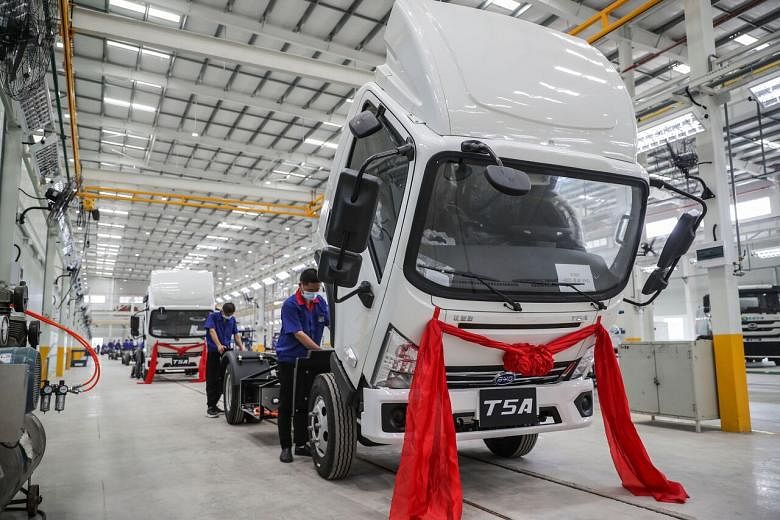BEIJING (CHINA DAILY/ASIA NEWS NETWORK) - China is the world's largest new energy vehicle (NEV) market, accounting for more than half of the global NEV market share.
During the past five years, the NEV market in China has reached 1.2 million units per year and enjoyed a fast annual growth of more than 50 per cent.
However, the Chinese NEV market is currently beset by a demand slowdown, the Covid-19 crisis and intensifying industry competition.
Looking back at the history of the auto industry, we can see that current short-term uncertainties indicate a restructuring of the competitive landscape that prevailed over the last century.
Looking ahead, the implementation of the Corporate Average Fuel Consumption and New Energy Vehicle (CAFC/NEV) credit program, or dual-credit policy as it is known, will expedite NEV penetration and guide the market onto a positive track.
NEV sales are expected to account for 25 per cent of vehicle sales in 2025, and they are expected to have a market share of about 35 per cent in 2030, driven by diversified industry policies and the growing NEV ecosystem.
In the future, the dual-credit policy will be more flexible than the subsidy policy.
It can offer directional guidance and motivation to NEV technologies and products by adjustment of credit proportion, and so guide auto companies to restructure their product portfolios, and create a virtuous cycle of market growth.
In the mid-to long-run, auto original equipment manufactures (OEMs) will benefit from the favourable demand prospects stemming from the rapid reduction in battery costs and the improvement of the charging network.
Although some battery raw materials are expected to rise as demand increases, battery costs are still likely to fall sharply.
Meanwhile, consumers show rising acceptance of NEVs and willingness to pay a premium.
Sales data in 2019 shows that mid/low-tier cities without purchase restrictions on vehicle sales have overtaken high-tier cities with purchase limitations in the share of NEV sales, becoming a key driver of sales growth.
A recent consumer study shows that over 60 per cent of China auto consumers are willing to pay a premium for NEVs.
At the same time, the supporting infrastructure is constantly improving. In response to the government's New Infrastructure Construction policy, energy, auto, battery and charging service companies have accelerated the deployment of charging networks nationwide.
Also a distribution chain for used NEVs has been established in each regional market. In the short - and mid-term, about 90 cities will grow as the main consumer cities of NEVs to promote rapid growth of the overall market and guide other regional markets to create and improve their NEV ecosystems.
Nonetheless, the NEV industry still faces plenty of challenges in the short term despite the mid-to long-term favourable environment.
First, it is hard to ensure sufficient production capacity for quality products. Frequent spontaneous battery combustion have sensitised consumers to high-quality batteries.
However, production capacity for high-quality batteries falls short of the battery needs of OEMs and this has become a bottleneck for their development.
Second, it is hard to master the core technologies. The key design parameter of finished vehicles relies heavily on the battery manufacturers as they control the core battery technologies, resulting in a clear conflict between the traditional development cycle of finished vehicles and the upgrade frequency of battery technologies.
Auto companies had expected to master and accumulate battery pack design technologies and experience by building module and encapsulation capacity. But with the development of Cell to Pack (CTP) batteries, they might face challenges again.
Third, NEV products are less differentiated. The reduced structural complexity of NEVs over internal combustion engine cars and the homogeneity of power system technology and product performance are challenging auto companies to develop ways of product differentiation.
Moreover, overall profitability is decreasing. The transfer of core technologies and rapid changes in supply chains weaken the auto companies' control over upstream suppliers.
The NEV industry profitability keeps falling and traditional OEMs face pressing challenges, as more giants from other industries with strong supply chain management capabilities join the game and the downstream after-market service mode changes.
Also, despite the oversupply, China's power battery market still suffers from insufficient high-quality production capacity and a long-term "structural imbalance".
The top battery players are major suppliers of various auto companies, with 70 per cent of the market share and multiple advantages in resources, technology, production and sales.
Players below tier 2 have clear technical weaknesses, low capacity utilisation rate and large financial pressure.
The top players are expected to grab more market share through capacity expansion. Tier 2 players with certain technical strengths and capacity will try to enter the supply chains of mainstream OEMs in order to obtain technical and production support and to gradually assume the role of secondary suppliers.
Other battery players in lower tiers will be rapidly forced out of the market. As subsidies decline and consumer sophistication increases, we anticipate that NEV design will align more with end-user scenarios and power battery technology road maps will diverge accordingly.
In the near future, it is expected that auto players will fall into three categories: service-oriented players, manufacturing-based players and new-type OEMs.
Those who actively seek for transformation and have user touchpoints will dominate the end market.
Those who lose user touchpoints will be eliminated from market or become contract manufacturers. A third group of players outside the industry will take active actions to seek a role as contract manufacturers.
The NEV market is changing rapidly. Chinese auto companies need to recognise the profound change in the NEV value chain, and take the pulse of the industry value if they are to win in the future NEV era.
The writer is a managing director and senior partner at Boston Consulting Group and the leader of BCG's Automotive and Mobility practice in China. China Daily is a member of The Straits Times media partner Asia News Network, an alliance of 24 news media organisations.

